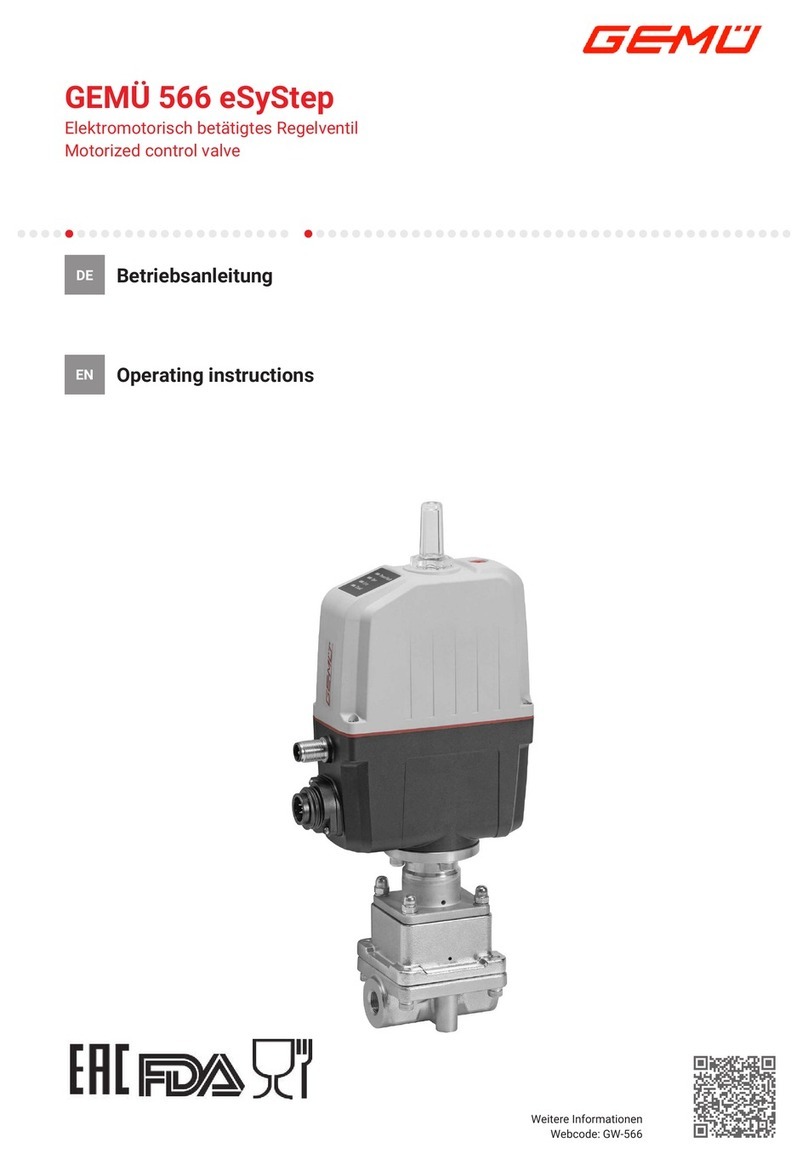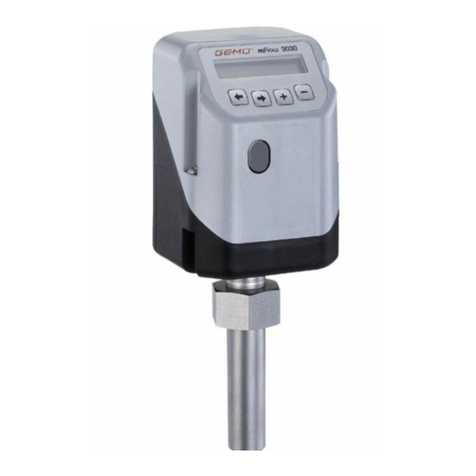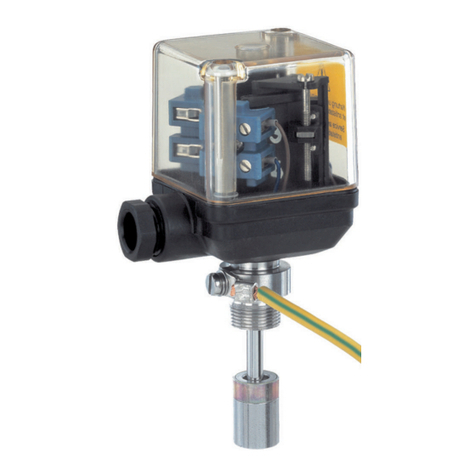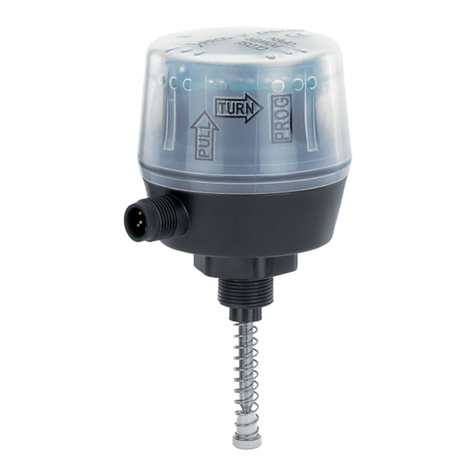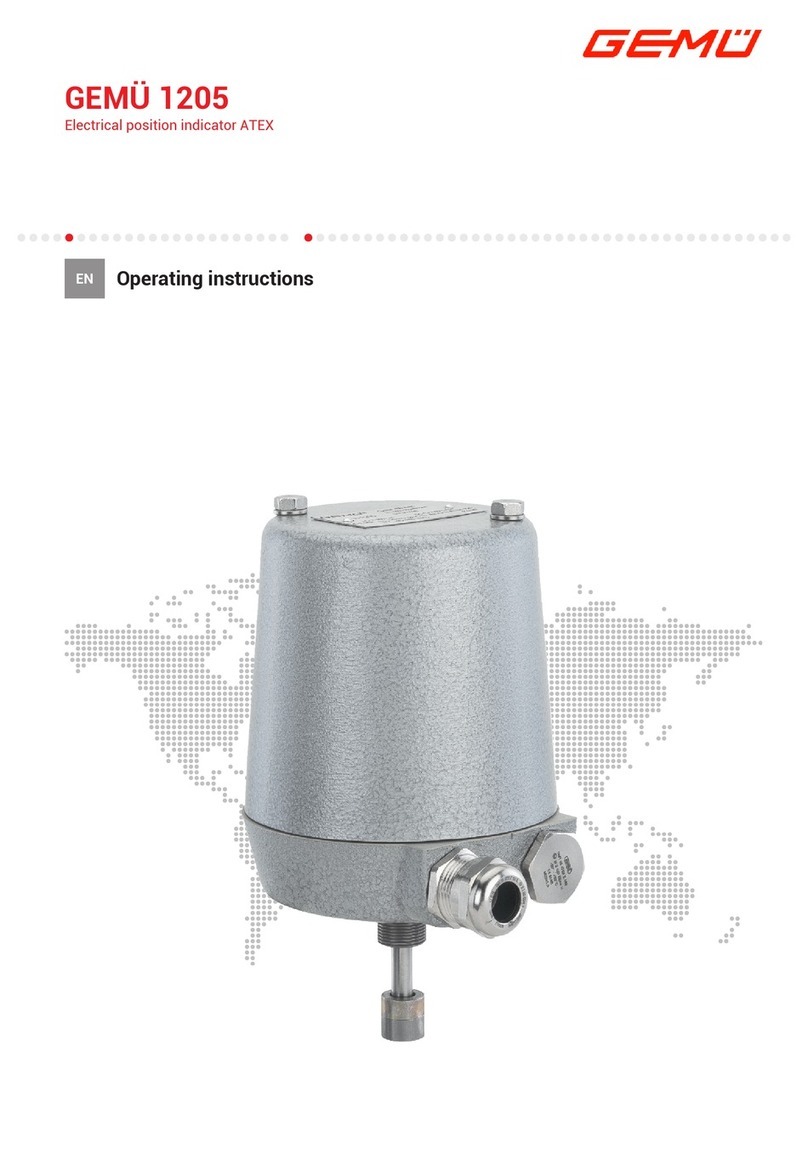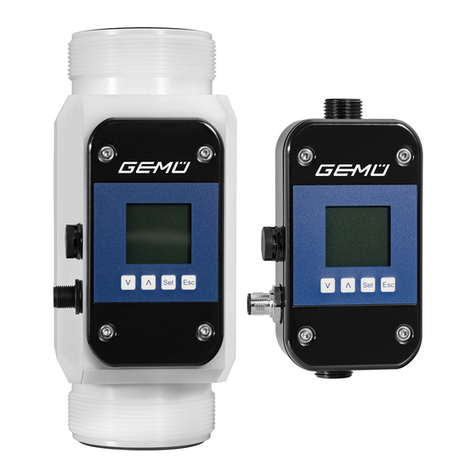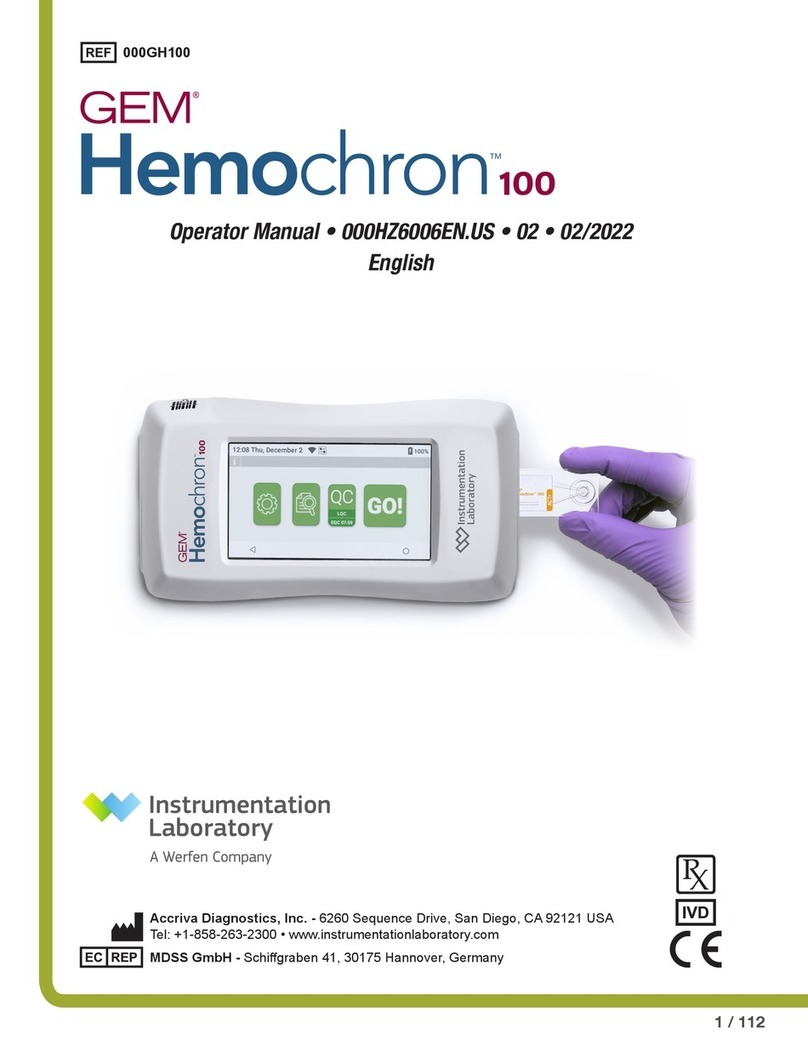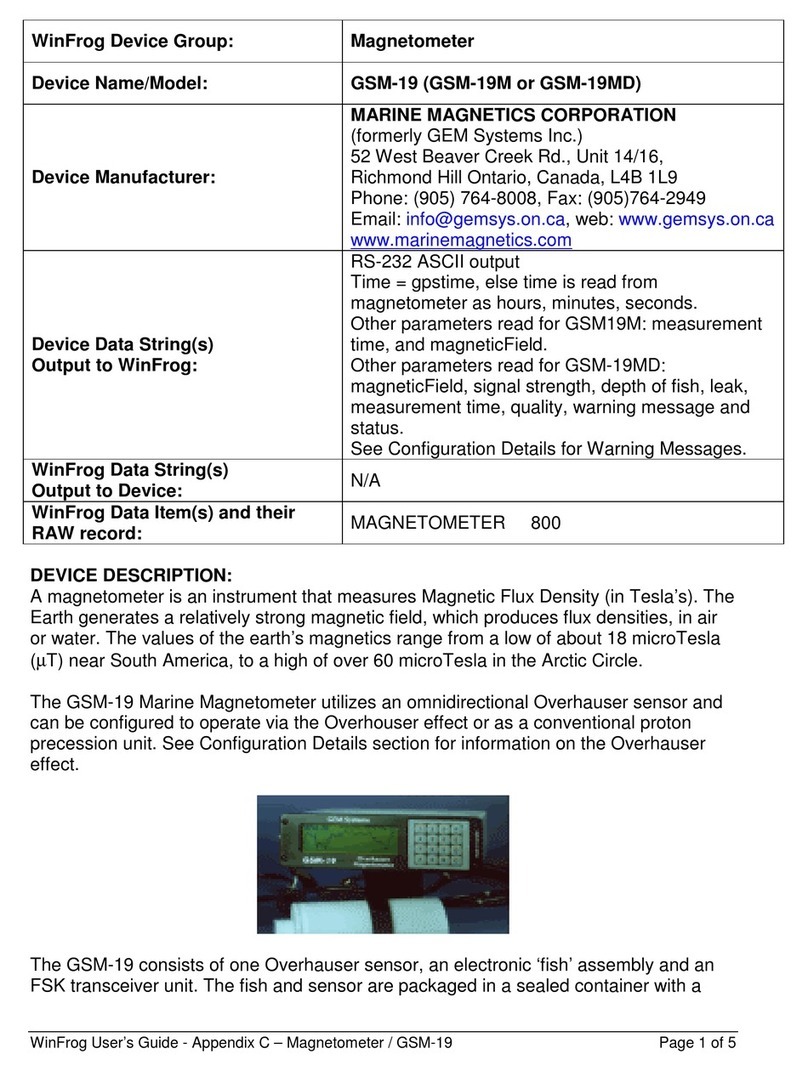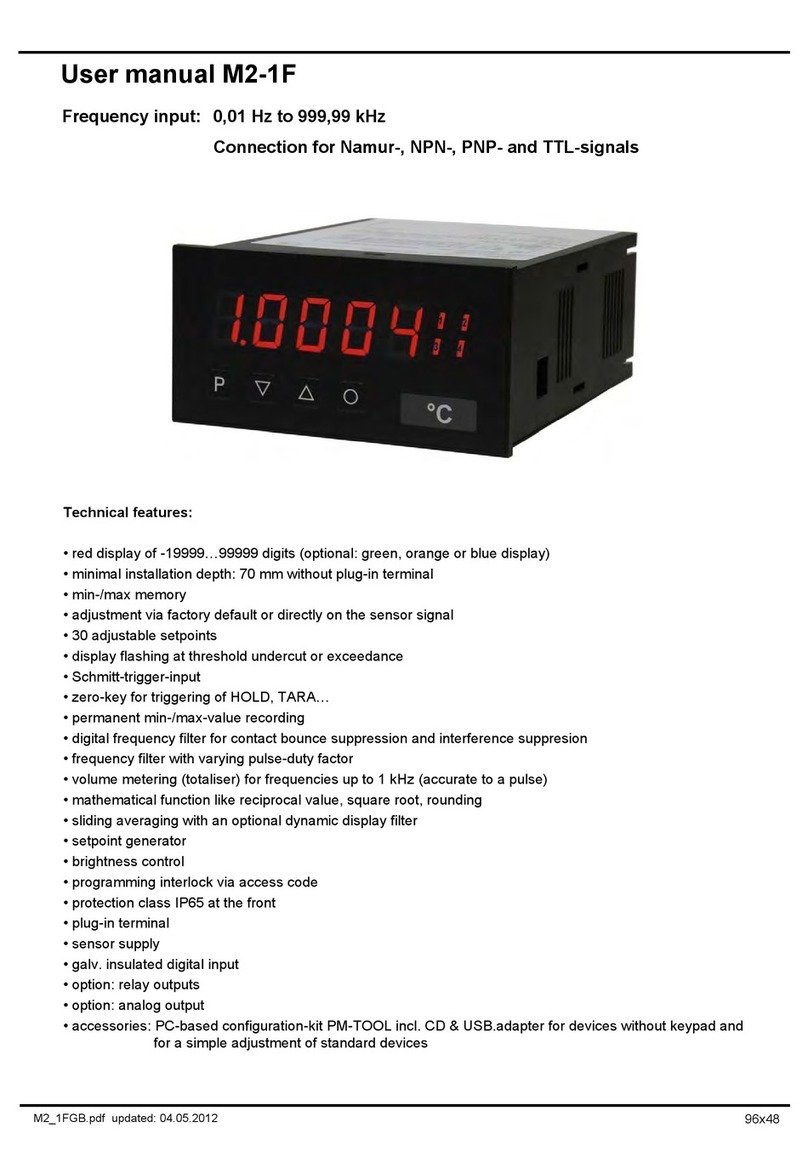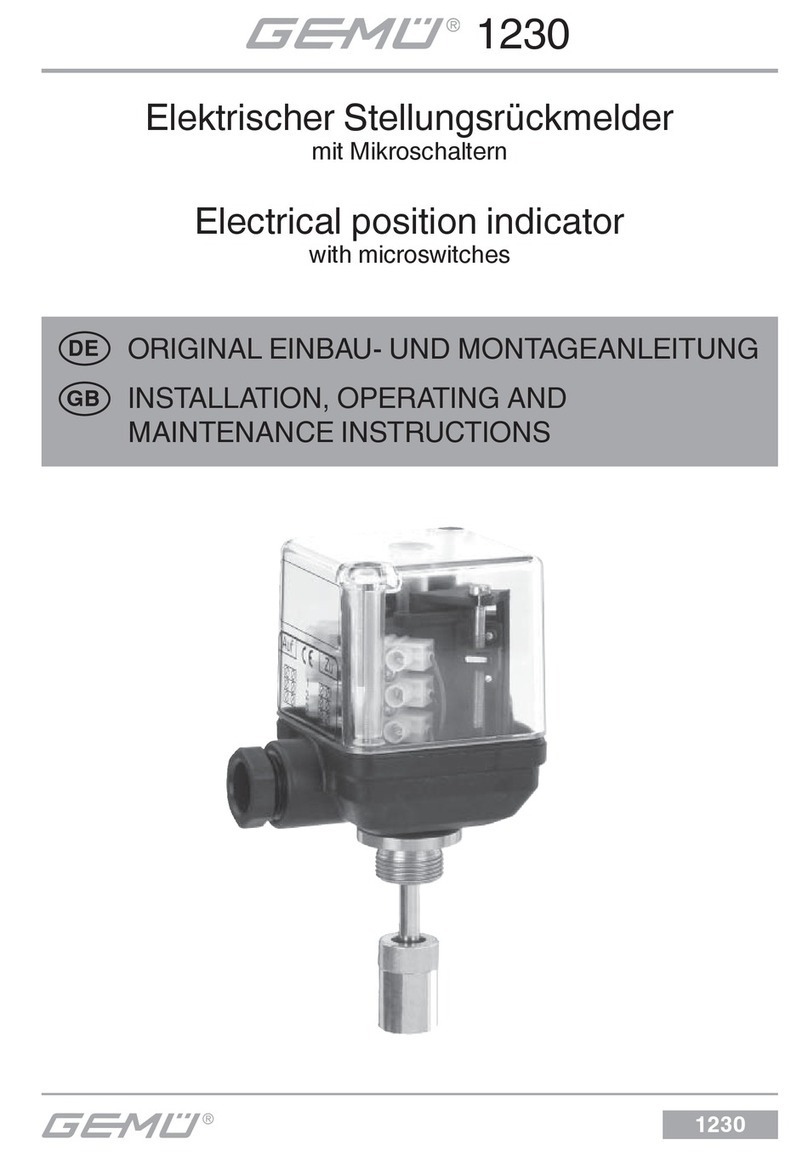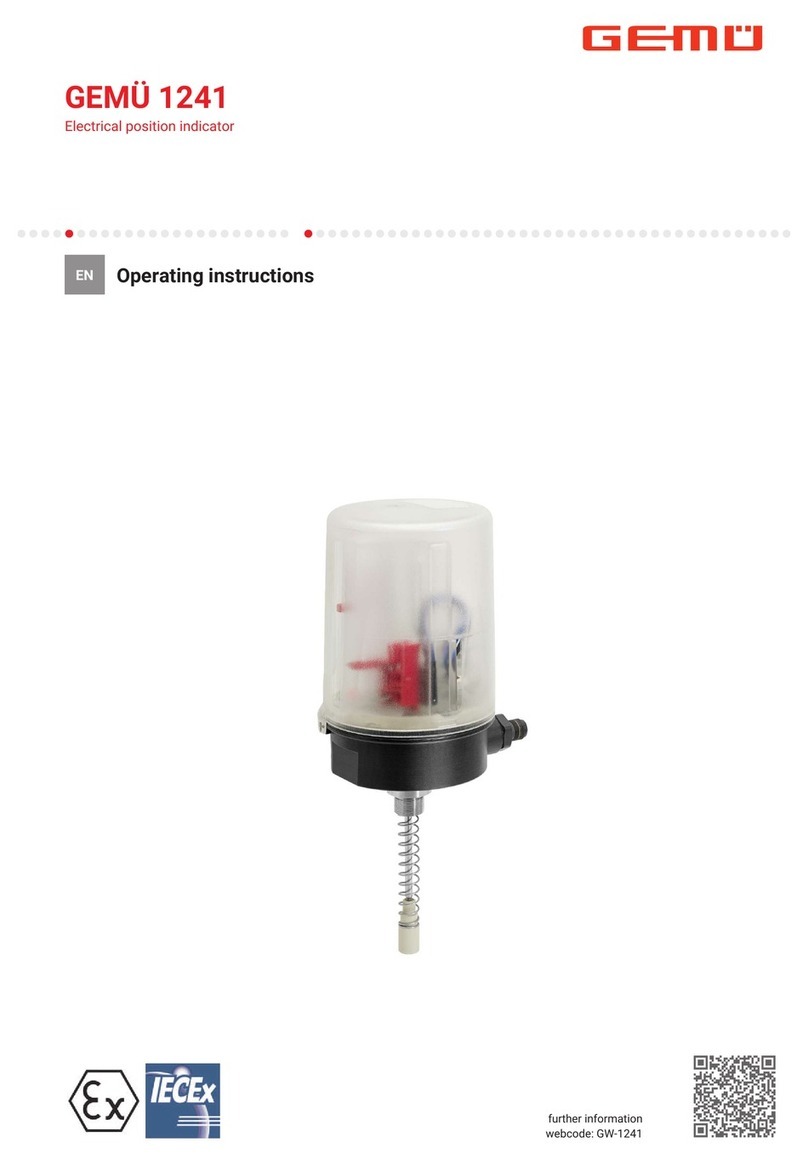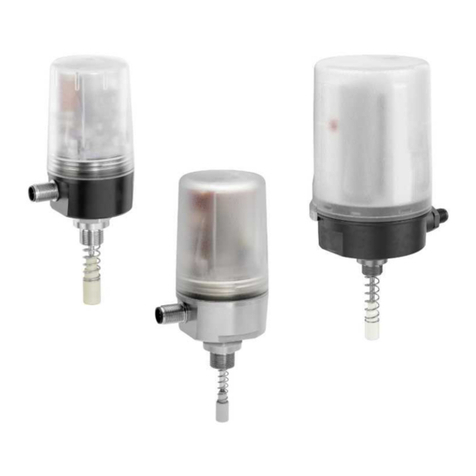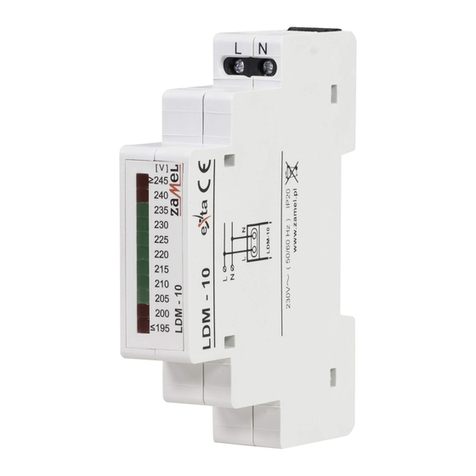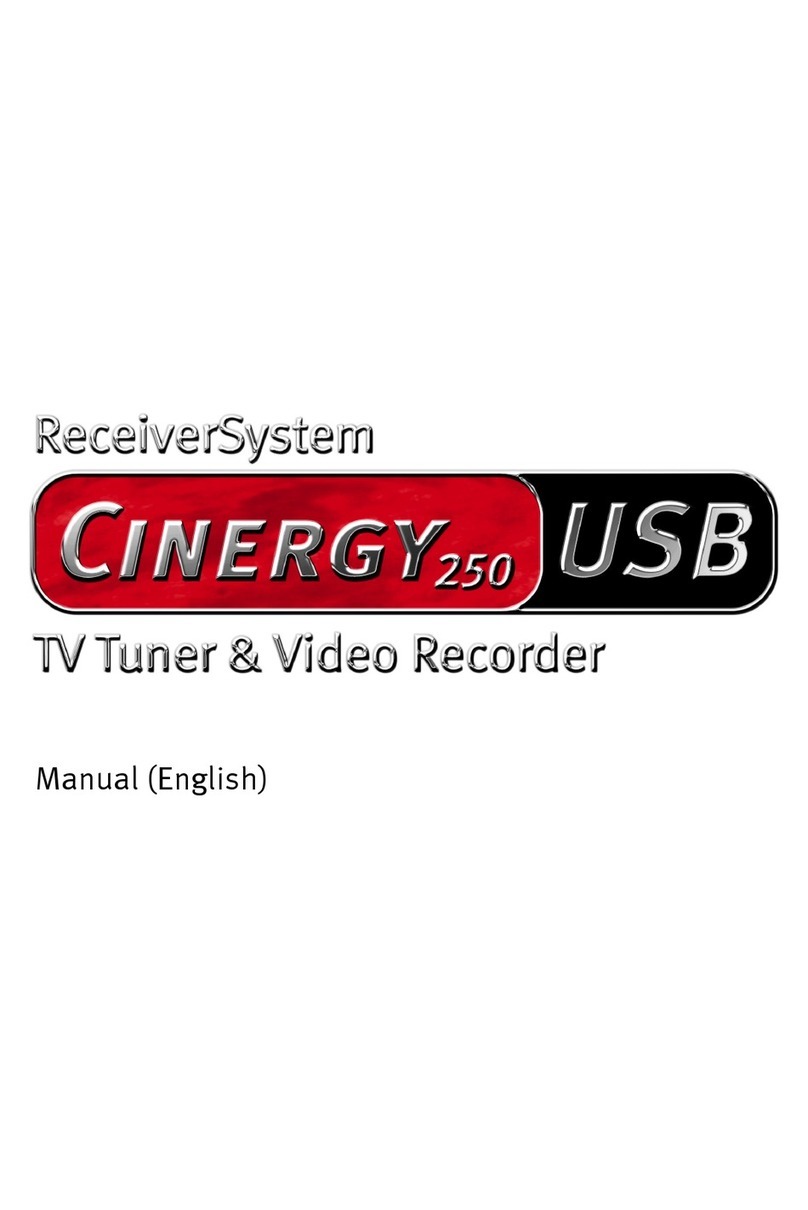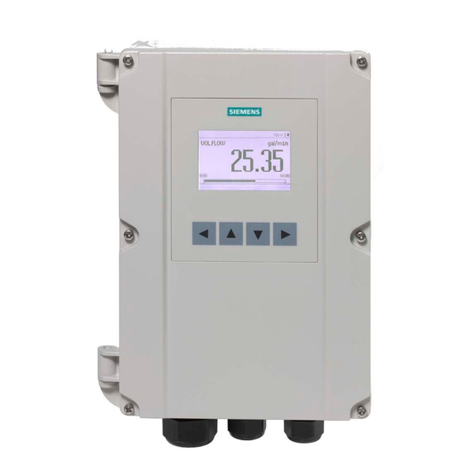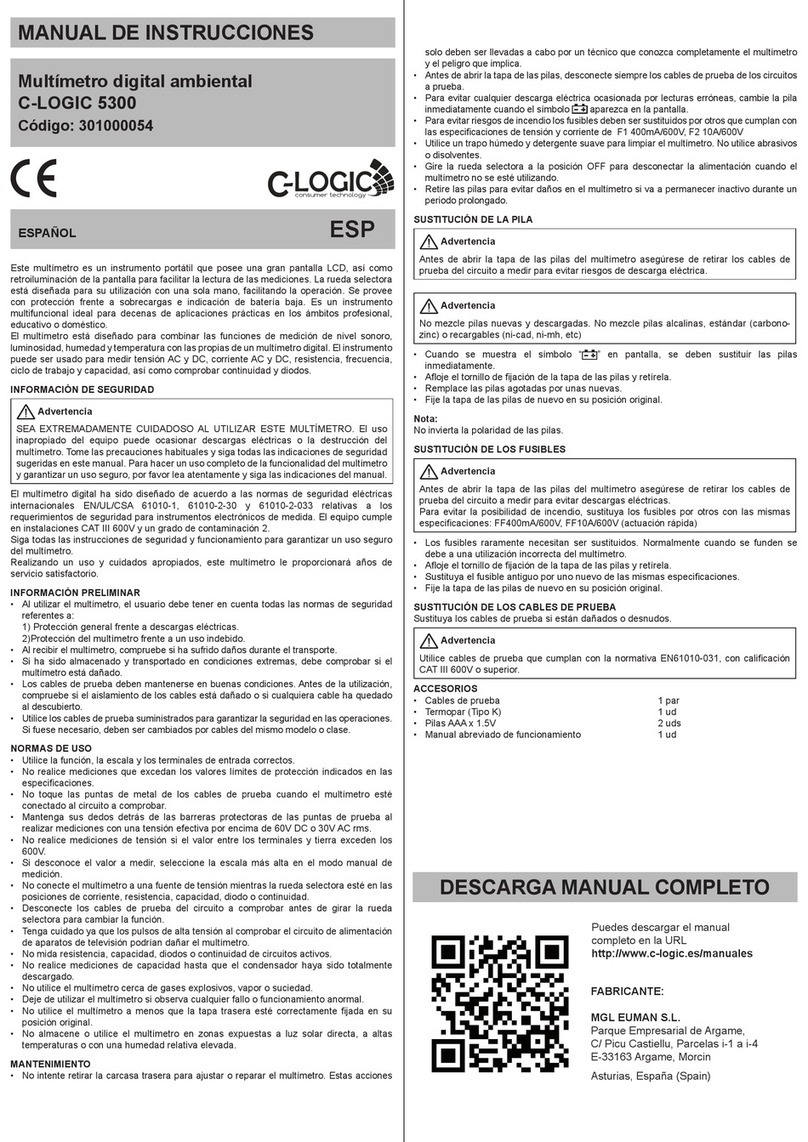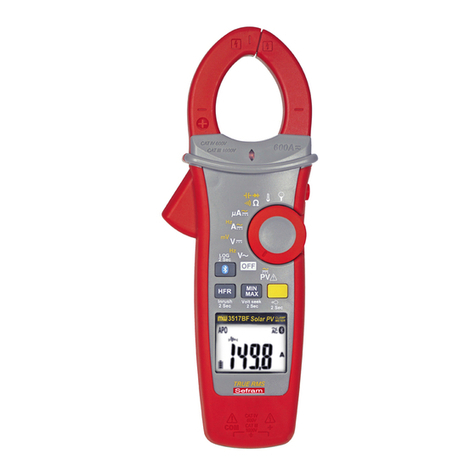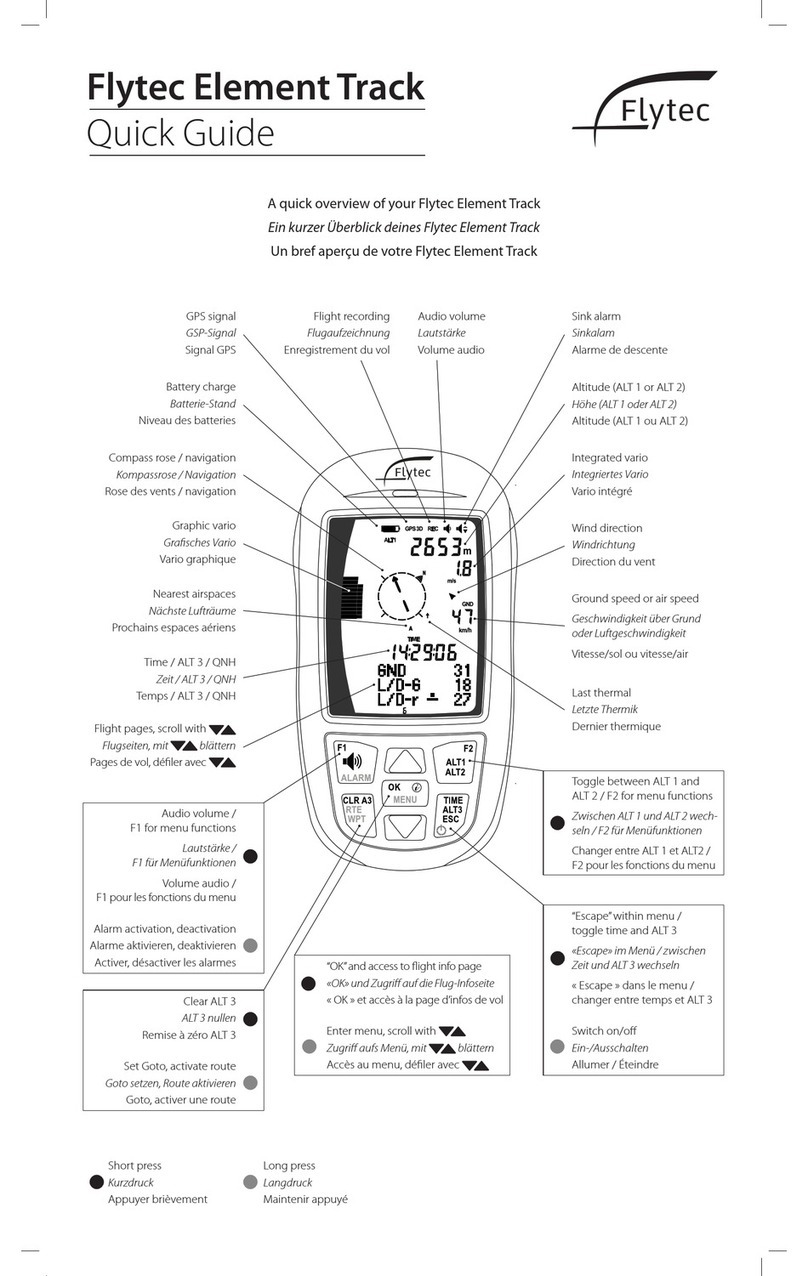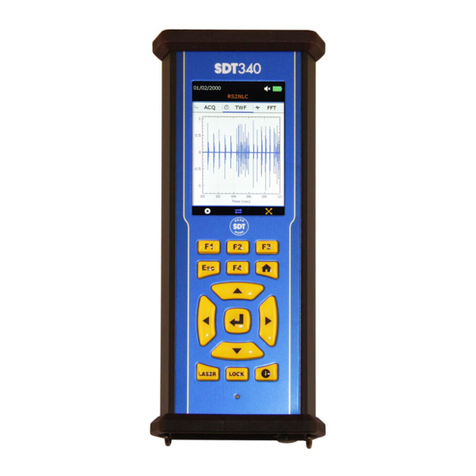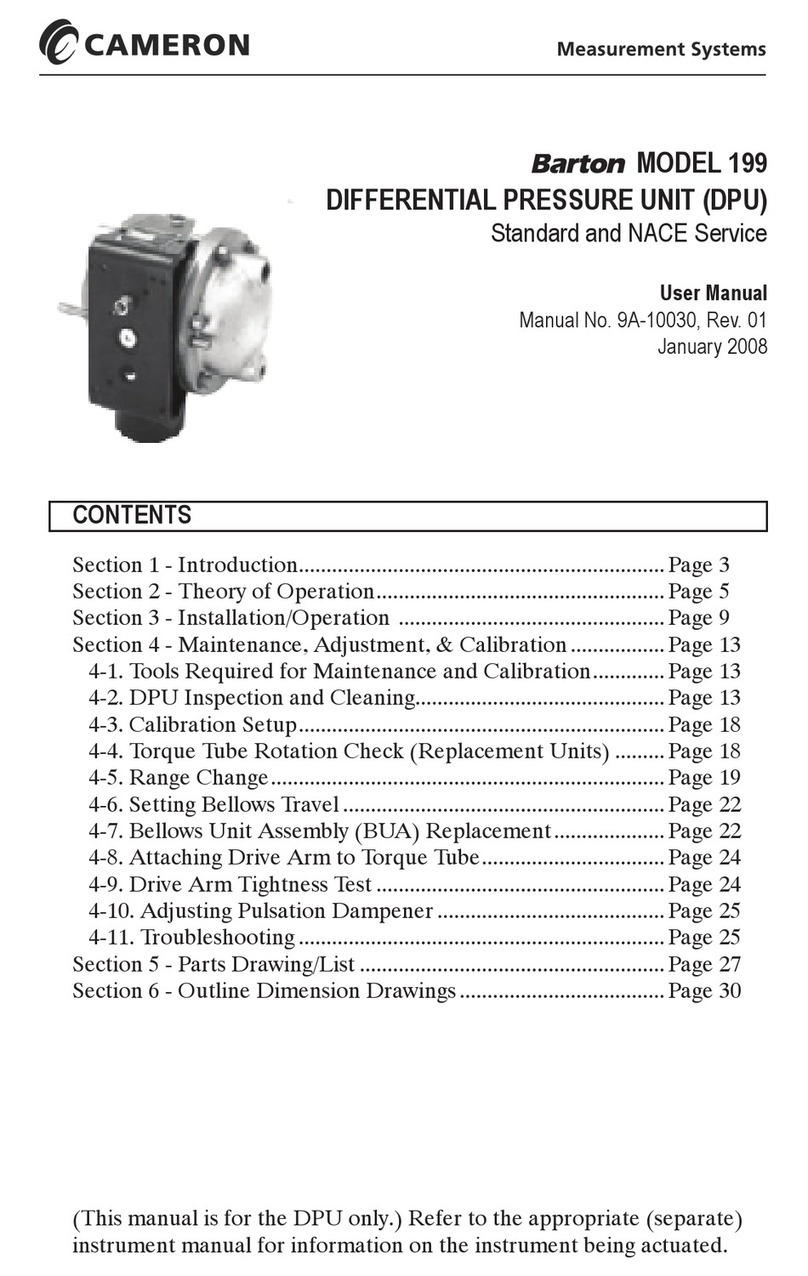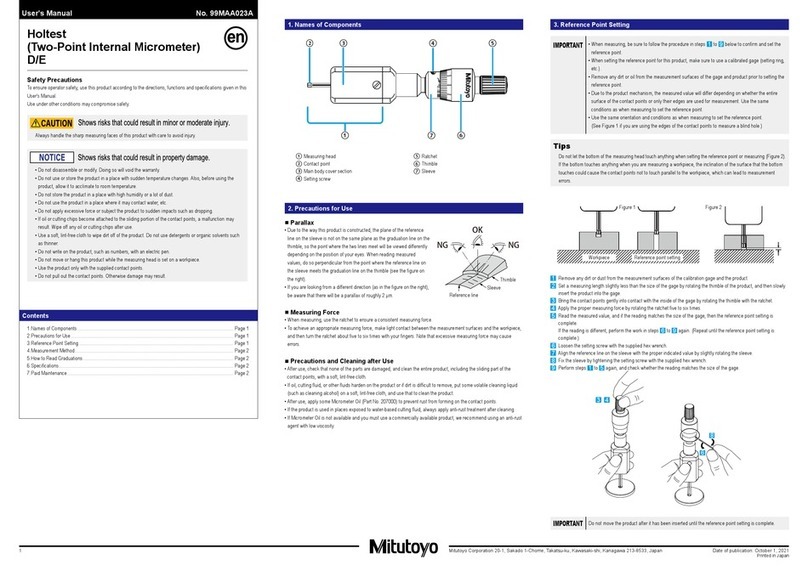GEM 3030 mFlow User manual

3030
Magnetically Inductive Flowmeter
QUICK GUIDE
GB
Magnetisch-Induktiver Durchflussmesser
3030 mFlow
ORIGINAL QUICK GUIDE
DE

3030 2 / 20
Inhaltsverzeichnis
1 Hinweise zu Ihrer Sicherheit 2
2 Montage 2
2.1 Montage allgemein 2
2.1.1 Montage mit
GEMÜ Einschweißhülse 4
2.1.2 Montage mit
GEMÜ Durchgangsgehäuse 4
2.1.3 Montage mit
GEMÜ Zwischenbauflansch 4
2.1.4 Montage mit Tuchenhagen
Varivent®In-Line Gehäuse 5
2.1.5 Montage mit Neumo BioControl®
Durchgangsgehäuse 5
3 Elektrische Anschlüsse 5
4 Ändern von Parametern 6
5 Inbetriebnahme 6
5.1 Konfigurationsmenü (Setup) 12
5.2 Menüstruktur 1. Service 12
5.3 Menüstruktur 2. SetBasics 14
5.4 Menüstruktur 3. SetFunction 16
5.5 Menüstruktur 4. SetCalibration 18
6 Betrieb 20
7 Hinweise 20
1 Hinweise zu Ihrer Sicherheit
Die Sicherheitshinweise entnehmen
Sie bitte der Bedienungsanleitung des
GEMÜ1435 ePos®, die über den folgenden
Link abrufbar ist:
https://www.gemu-group.com/
webcode/?webcode=GW-3030
2 Montage
2.1 Montage allgemein
Vor dem Einbau des GEMÜ 3030 mFlow in
die Rohrleitung die Rohrleitung entleeren
und soweit abkühlen, dass Verätzungen
durch Medium und Verbrühungen
ausgeschlossen sind.
Der Sensor sollte vorzugsweise
in einer vertikalen Steigleitung mit
Durchflussrichtung nach oben eingebaut
werden. Der Einbau in Fallleitungen sollte
nach Möglichkeit vermieden werden. Es
muss auf ständig befüllte Rohrleitungen
geachtet werden.
Durchfluss
In horizontalen Leitungen muss der Einbau
des Sensors so erfolgen, dass keine
Lufteinschlüsse entstehen können, da sonst
das Messergebnis verfälscht wird.
Richtig
Lufteinschlüsse
Falsch
Lufteinschlüsse

3 / 20 3030
Hinter dem GEMÜ 3030 mFlow darf sich
kein freier Auslauf befinden, damit die
Rohrleitung immer komplett befüllt ist.
Richtig
Durchfluss
Falsch
Durchfluss
Zusätzlich sollte der Durchflussmesser
in horizontaler Einbaulage seitlich in dem
unten angegebenen Bereich angebracht
werden.
Bevorzugte Einbaulage
Nichtempfohlene Einbaulage
Gefahr von Lufteinschlüssen
Gefahr von
Feststoffablagerungen
Um Verwirbelungen durch
Leitungskrümmungen zu vermeiden, die das
Messergebnis verfälschen können, sollte
eine gerade Einlaufstrecke von 10 x DN
und eine gerade Auslaufstrecke von 5 x DN
vorgesehen werden.
Durchfluss
Das Elektronikgehäuse mit dem Display ist
um 370° drehbar.
X3
15
43
2
Anlagenbedingt können
Potentialunterschiede zwischen Rohrleitung
und Bezugserde auftreten. Um diese zu
beseitigen, die Rohrleitung vor und nach
dem Durchflussmesser erden.
Wichtig:
Zur Gewährleistung der
Messgenauigkeit muss der
GEMÜ 3030 mFlow mindestens
24 h vor der Messung in die gefüllte
Rohrleitung installiert werden.

3030 4 / 20
2.1.1 Montage mit GEMÜ
Einschweißhülse
VORSICHT
Einschweißhülse nicht mit eingebautem
Durchflussmesser einschweißen!
Durchfluss
Arretie-
rungs-
nase
Abbildung 1 Abbildung 2
Abbildung 3
Tabelle Einbaumaße
DN T [mm]
25 4,5
32 6,0
40 7,2
50 8,3
65 10,0
80 12,0
100 14,5
125 17,5
150 20,5
200 27,0
250 33,0
300 39,5
Weitere Einbaumaße
auf Anfrage
Die Einbautiefe L errechnet sich aus
folgender Formel: L = 79 - S - T
S = Wandstärke der Rohrleitung
T = Kann aus Tabelle Einbaumaße für
jeweilige Rohrleitung entnommen
werden
1. Bohrung ø 33 in Rohrleitung bohren.
2. Einschweißhülse (Abbildung 1) in die
Bohrung stecken.
3. Arretierungsnase 90° zur
Durchflussrichtung ausrichten
(Abbildung 2).
4. Einschweißhülse mit dem der
Nennweite entsprechenden Einbaumaß
(Abbildung 3 / Einbaumaße siehe
Tabelle Einbaumaße) senkrecht zur
Rohrleitungsachse einschweißen.
5. Durchflussmesser aufstecken
(Arretierungsnase gegen Verdrehen
beachten).
6. Durchflussmesser mit der
Überwurfmutter (M33x2, SW36) auf der
Einschweißhülse befestigen.
2.1.2 Montage mit GEMÜ
Durchgangsgehäuse
1. Durchgangsgehäuse in die Leitung
einbauen.
2. Durchflussmesser aufstecken
(Arretierungsnase gegen Verdrehen
beachten).
3. Durchflussmesser mit der
Überwurfmutter (M33x2, SW36) auf dem
Durchgangsgehäuse befestigen.
2.1.3 Montage mit GEMÜ
Zwischenbauflansch
1. Zwischenbauflansch in die Leitung
einbauen.
2. Durchflussmesser aufstecken
(Arretierungsnase gegen Verdrehen
beachten).
3. Durchflussmesser mit der
Überwurfmutter (M33x2, SW36) auf dem
Zwischenbauflansch befestigen.
Abbildung 3

3030
5 / 20
2.1.4 Montage mit Tuchenhagen
Varivent®In-Line Gehäuse
Wichtig:
Die Elektroden des Sensors
müssen immer genau quer zur
Durchflussrichtung des Mediums
ausgerichtet werden, um eine
genaue Messung zu ermöglichen.
1. Varivent®In-Line Gehäuse in die
Rohrleitung einschweißen.
2. Durchflussmesser mit aufgeschweißter
Verschlussplatte auf das Gehäuse setzen.
3. Auf richtige Ausrichtung des Sensors
achten (Elektroden / Markierungen 90°
zur Durchflussrichtung).
4. Durchflussmesser mit dem Klemmring
auf dem Gehäuse befestigen.
2.1.5 Montage mit
Neumo BioControl®
Durchgangsgehäuse
Wichtig:
Die Elektroden des Sensors
müssen immer genau quer zur
Durchflussrichtung des Mediums
ausgerichtet werden, um eine
genaue Messung zu ermöglichen.
1. BioControl®Durchgangsgehäuse in die
Rohrleitung einschweißen.
2. Durchflussmesser mit aufgeschweißter
Verschlussplatte auf das BioControl®
Durchgangsgehäuse setzen.
3. Auf richtige Ausrichtung des
Sensors achten (Elektroden 90° zur
Durchflussrichtung).
4. Durchflussmesser auf dem Gehäuse
festschrauben.
3 Elektrische Anschlüsse
Sämtliche elektrischen Anschlüsse sind
als 5-polige M12 Anschlusstecker auf
der Rückseite des Durchflussmesser
angebracht.
Anschluss Pin Bezeichnung
X1
A-kodiert
M12-Stecker
1 Uv, 24V DC Versorgungsspannung
2 Schließer, Ausgang K1, 24V DC
3 GND
4 Schließer, Ausgang K2, 24V DC
5 n.c.
Anschluss Pin Bezeichnung
X2
B-kodiert
M12-Stecker
1 n.c.
2 n.c.
3 RXD, RS 232
4 TXT, RS 232
5 GND, RS 232
Anschluss Pin Bezeichnung
X3
A-kodiert
M12-Stecker
1 I+, Stromausgang
2 I-, Stromausgang
3 Funktionserde
4 24V DC, Impulsausgang
5 GND, Impulsausgang
Wichtig:
Bei der Profibus-DP Ausführung
fällt die RS-232 Schnittstelle weg.
Verschlussplatte
Ansicht von
Unterseite
des Sensors
Durchfluss
Sensor
Elektroden
Markierungen
Ansicht von
Unterseite
des Sensors
Durchfluss
Sensor
Elektroden

3030 6 / 20
4 Ändern von Parametern
Beim GEMÜ 3030 mFlow werden mit Hilfe
der Tasten die verschiedenen
Menüs ausgewählt.
Die Veränderung der gewünschten
Parameter geschieht mit Hilfe von
Klammern, die um den betreffenden
Parameter gesetzt werden.
Mit den oder Tasten setzt man den
Cursor auf den betreffenden Parameter und
ändert diesen mit der oder Taste.
Beispiel:
Ändern der Maßeinheit (Unit) von l/h auf
l/min
5 Inbetriebnahme
Der Durchflussmesser GEMÜ 3030 mFlow
ist werkseitig kalibriert und somit nach
Anlegen der Betriebsspannung sofort
betriebsbereit.
Folgende Einstellung sollten vorgenommen
werden:
GMaßeinheit einstellen (SetBasics / Unit)
GNetzfrequenz eingeben (SetBasics /
F.Line)
GAnalogausgang einstellen
(SetFunction / Analog Output)
GFunktion der Relaisausgänge festlegen
(SetFunction / Digital Output)
GArt und Größe des Fitting eingeben
(SetCalibration / Pipe)

Contents
1 Safety instructions 7
2 Assembly 7
2.1 General assembly information 7
2.1.1 Assembly with a GEMÜ weldolet 9
2.1.2 Assembly with a
GEMÜ in-line housing 9
2.1.3 Assembly with a
GEMÜ wafer type flange 9
2.1.4 Assembly with a Tuchenhagen
Varivent®in-line housing 10
2.1.5 Assembly with a Neumo
BioControl®in-line housing 10
3 Electrical connections 10
4 Changing parameters 11
5 Commissioning 11
5.1 Configuration menu (setup) 12
5.2 Menu structure 1. Service 12
5.3 Menu structure 2. SetBasics 14
5.4 Menu structure 3. SetFunction 16
5.5 Menu structure 4. SetCalibration 18
6 Operation 20
7 Notes 20
1 Safety instructions
Please refer to the safety instructions
included in the GEMÜ 1435 ePos®operating
instructions which can be accessed via the
following link:
https://www.gemu-group.com/
webcode/?webcode=GW-3030
2 Assembly
2.1 General assembly
information
Before installation of the GEMÜ 3030 mFlow
in a pipeline, the pipeline must be emptied
and cooled to the extent that chemical burns
and scalding by the medium can be avoided.
We recommend installation of the sensor
in a vertical rising mains with an upwards
direction of flow. Installation in a downpipe
should be avoided if possible.
Ensure that the pipe-lines are always filled.
Flow
In horizontal pipes the sensor must be
installed so that air cannot be trapped,
otherwise the measurement result will be
distorted.
Correct
Air traps
Incorrect
Air traps
7 / 20 3030

3030
Upstream of the GEMÜ 3030 mFlow no free
outlet is allowed to ensure that the pipeline
is always completely filled.
Correct
Flow
Incorrect
Flow
In addition, the flowmeter must be installed
in a horizontal mounting position at the side
of the area defined below.
Preferred installation position
Non-recommended installation position
Danger of trapped air
Danger of solid matter
deposits
In order to avoid turbulence as a result
of pipe bending which can falsify the
measurement results, a straight inlet
distance of 10 x DN and a straight outlet
distance of 5 x DN should be planned.
Flow
The electronics housing with display can be
rotated through 370°.
X3
15
43
2
For plant-specific reasons earth potential
differences between pipeline and reference
earth may occur. Earth the pipeline before
and after the flowmeter to eliminate these
differences.
Important:
To guarantee the measuring
accuracy, the GEMÜ 3030 mFlow
must be installed in the filled
pipeline at least 24 hours before
measurement.
8 / 20

2.1.1 Assembly with a
GEMÜ weldolet
CAUTION
Weld in the weldolet without the flowmeter!
Mounting depth L is calculated as follows:
L = 79 - S - T
S = Wall thickness of pipeline
T = Please refer to the table of mounting
dimensions for the respective pipeline
size
1. Bore a hole ø 33 in the pipeline.
2. Lodge the weldolet (figure 1) in the hole.
3. Align the locking wings at 90° to the flow
direction (figure 2).
4. Weld the weldolet with the mounting
dimensions "T" corresponding to the
nominal size (figure 3) perpendicular
to the pipeline axis (please refer to the
mounting dimensions table).
5. Insert the flowmeter into the weldolet
when cooled (make sure the locking
wings do not become twisted).
6. Attach the flowmeter to the weldolet
using the union nut (M33x2, SW36).
2.1.2 Assembly with a
GEMÜ in-line housing
1. Attach the in-line housing to the line.
2. Insert the flowmeter into it (make sure
the locking wings do not become
twisted).
3. Attach the flowmeter to the in-line
housing with the union nut
(M33x2, SW36).
2.1.3 Assembly with a
GEMÜ wafer type flange
1. Attach the wafer type flange (with an
O-ring) to the line.
2. Insert the flowmeter into it (make sure
the locking wings do not become
twisted).
3. Attach the flowmeter to the wafer
type flange with the union nut
(M33x2, SW36).
Flow
Locking
wing
Figure 1 Figure 2
Figure 3
Table of mounting
dimensions
DN T [mm]
25 4.5
32 6.0
40 7.2
50 8.3
65 10.0
80 12.0
100 14.5
125 17.5
150 20.5
200 27.0
250 33.0
300 39.5
Further dimensions
on request
9 / 20 3030

3030
2.1.4 Assembly with a
Tuchenhagen Varivent®
in-line housing
Important:
The sensor electrodes must always
be positioned exactly across the
medium's flow direction in order to
enable accurate measurement.
1. Weld the Varivent®in-line housing into
the pipeline.
2. Put the flowmeter with the welded cover
plate into the housing.
3. Observe correct alignment of the sensor
(electrodes / markings at 90° to the flow
direction).
4. Attach the flowmeter to the housing with
a clamping ring.
2.1.5 Assembly with a
Neumo BioControl®
in-line housing
Important:
The sensor electrodes must always
be positioned exactly across the
medium's flow direction in order to
enable accurate measurement.
1. Weld BioControl®in-line housing into the
pipeline.
2. Put the flowmeter with the welded cover
plate into the BioControl®in-line housing.
3. Observe correct alignment of the sensor
(electrodes 90° to the flow direction).
4. Screw down the flowmeter to the
housing.
3 Electrical connections
All electrical connections are 5-pin M12
connectors fitted at the rear of the housing.
Connection Pin Signal name
X1
A coded
M12 plug
1 Uv, 24V DC supply voltage
2 Make-contact, output K1, 24V DC
3 GND
4 Make-contact, output K2, 24V DC
5 n.c.
Connection Pin Signal name
X2
B coded
M12 plug
1 n.c.
2 n.c.
3 RXD, RS 232
4 TXT, RS 232
5 GND, RS 232
Connection Pin Signal name
X3
A coded
M12 plug
1 I+, current output
2 I-, current output
3 Function earth
4 24V DC, impulse output
5 GND, impulse output
Important:
The Profibus-DP version has no
RS-232 interface.
Cover plate
View from
underside
of sensor
Flow
Sensor
Electrodes
Markings
View from
underside
of sensor
Flow
Sensor
Electrodes
10 / 20

4 Changing parameters
The keys are used for the GEMÜ
3030 mFlow to select the various menus.
When changes to the parameters are
required brackets are put around the values.
Use the or key to move the cursor onto
the respective parameter and change it with
the or the keys.
Example:
Changing the measurement unit from l/h to
l/min
5 Commissioning
The GEMÜ 3030 mFlow flowmeter is
calibrated at the factory and therefore ready
for operation when the operating voltage is
connected.
The following settings are necessary:
GSet measurement unit (SetBasics / Unit)
GEnter mains frequency (SetBasics /
F.Line)
GSet analogue output
(SetFunction / Analog Output)
GDetermine function of relay outputs
(SetFunction / Digital Output)
GEnter type and size of fitting
(SetCalibration / Pipe)
11 / 20 3030

3030
Logout?
OK
Code: 0
Active Level: 3
0...1000
Service
1
hrs. XXXXX:XX:XX
I / O Status
1.1
Login
1.2
Version 1.1.1.1
Diagnosis
1.3
3030 specific
1.4
Error List
NewCode:1 0
0...10000
v: XX.X m/s Q: XXX.X l/h
r0w- r0w-
r1w1r1w1r0w0
r0w0 r0w-
r0w-
T: XXX.X °C
r0w-
Min - T - Max
XXX,X °C XXX,X °C
r0w-
Nur verfügbar bei Geräteausführung MT2
Only available in Device Version MT2
Nur verfügbar bei Geräteausführ
u
Only available in Device Version
M
Return TQ2: XXX.X l
r0w3
TQ2 Mode OFF
ON...OFF
r0w3
Csak MT2 készülékkivitel esetén áll rendelkezésre Csak MT2 készülékkivitel esetén áll
5.1 Configuration menu
(setup)
5.2 Menu structure
1. Service
12 / 20
5.1 Konfigurationsmenü
(Setup)
5.2 Menüstruktur
1. Service

S/N 743984/ 1
Seriennummer
Return
Return
1.5
Warnings On
On...Off
Clear Error List
OK
Return
NewCode:2 0
0...10000
Return
NewCode:3 0
0...10000
Dir.: positiv Output K1 : K2 : K3
r0w- r0w-
r3w3r2w2
r0w3 r0w3
r0w-
Reset Min T Max
r0w3
u
ng MT2
M
T2
Nur verfügbar bei Geräteausführung MT2
Only available in Device Version MT2
I out XX.X mA
r0w-
TQ1: XXX.X l
r0w2
TQ1 Mode OFF
ON...OFF
r0w2
rendelkezésre Csak MT2 készülékkivitel esetén áll rendelkezésre
13 / 20 3030

3030
Q+v
Q+T
Q+TQ1
Q+TQ2
v+TQ1
v+TQ2
TQ1+TQ2
v+T
l/h
l/min
m³/min
GAL/min*
gal/min**
BBL/min***
bbl/min****
L/h
m³/h
GAL/h*
gal/h**
BBL/h***
bbl/h****
Csak MT2 készülékkivitel esetén áll rendelkezésre
5.3 Menu structure
2. SetBasics
14 / 20
5.3 Menüstruktur
2. SetBasics

15 / 20 3030

3030
A rendelkezésre állás a K3 Fn beállítástól függ
5.4 Menu structure
3. SetFunction
16 / 20
5.4 Menüstruktur
3. SetFunction

I out onWar
K2 delay
K1 delay
K3 delay
A rendelkezésre állás a K1 Fn beállítástól függ
A rendelkezésre állás a K2 Fn beállítástól függ
Csak akkor áll rendelkezésre, ha K3 Fn = impulzusok Csak akkor áll rendelkezésre, ha PulseOutput = impulzus/l Csak akkor áll rendelkezésre, ha PulseOutput = l/impulzus
17 / 20 3030

3030
Csak akkor áll rendelkezésre, ha típusok = GEMÜ Csak akkor áll rendelkezésre, ha típusok = GEMÜ
5.5 Menu structure
4. SetCalibration
18 / 20
5.5 Menüstruktur
4. SetCalibration

19 / 20 3030

6 Operation
Important note for
service and maintenance:
Adhesions on the sensor rod may
falsify the measurement result.
Regularly check the sensor rod (in
accordance with the application
conditions) and, if necessary,
remove the adhesions with a soft
cloth.
The sensor must be free of
medium-repellent substances.
Ensure that the sensor rod does not
become damaged.
7 Information
Note:
Handling, assembly,
commissioning, connection, setting
and adjustment may only be carried
out by authorised specialist staff.
GEMÜ shall assume no liability
whatsoever for damages caused
by improper handling or third-party
actions.
In case of doubt, contact GEMÜ
before commissioning.
Note on stafftraining:
Please contact us at the address
on the last page for stafftraining
information.
Should there be any doubts or
misunderstandings in the preceding text,
the German version of this document is the
authoritative document!
Änderungen vorbehalten · Subject to alteration · 07/2021 · 88266281
GEMÜ Gebr. Müller Apparatebau GmbH & Co. KG · Fritz-Müller-Str. 6-8 · D-74653 Ingelfingen-Criesbach
6 Betrieb
Wichtiger Hinweis für
Wartung und Service:
Anhaftungen am Sensorstab
können das Messergebnis
verfälschen!
Sensorstab regelmäßig
(entsprechend den
Einsatzbedingungen) überprüfen
und falls nötig die Anhaftungen mit
einem weichen Tuch entfernen.
Der Sensor muss unbedingt frei von
mediumabweisenden Stoffen sein.
Darauf achten, dass der Sensorstab
dabei nicht beschädigt wird!
7 Hinweise
Hinweis:
Handhabung, Montage und
Inbetriebnahme, sowie Anschluss-,
Einstell- und Justierarbeiten, dürfen
nur von autorisiertem Fachpersonal
durchgeführt werden.
Für Schäden welche durch
unsachgemäße Handhabung
oder Fremdeinwirkung entstehen,
übernimmt GEMÜ keinerlei Haftung.
Nehmen Sie im Zweifelsfall vor
Inbetriebnahme Kontakt mit GEMÜ
auf.
Hinweis zur Mitarbeiterschulung:
Zur Mitarbeiterschulung nehmen
Sie bitte über die Adresse auf der
letzten Seite Kontakt auf.
Im Zweifelsfall oder bei Missverständnissen
ist die deutsche Version des Dokuments
ausschlaggebend!
Other manuals for 3030 mFlow
1
Table of contents
Other GEM Measuring Instrument manuals
Popular Measuring Instrument manuals by other brands
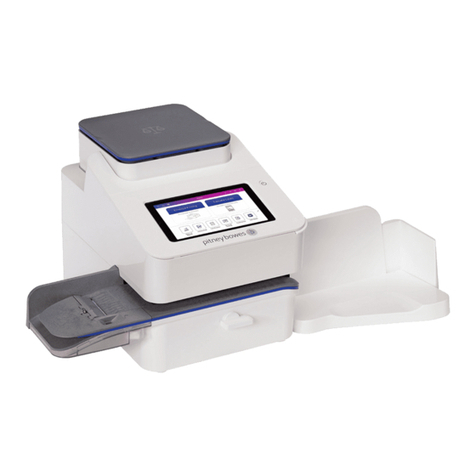
Pitney Bowes
Pitney Bowes SendPro C Lite user guide
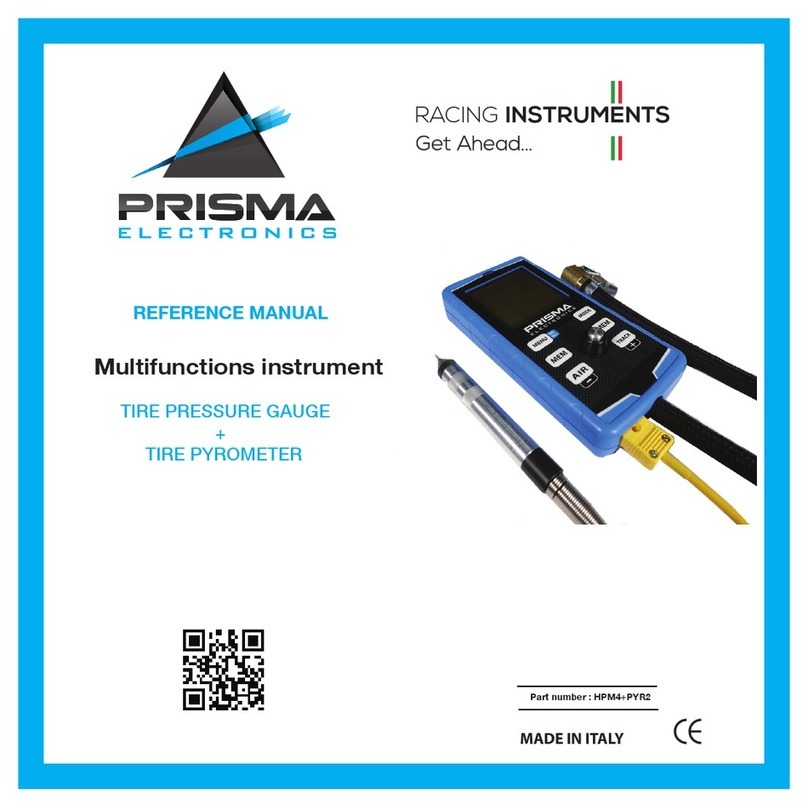
Prisma Electronics
Prisma Electronics HPM4+PYR2 Reference manual
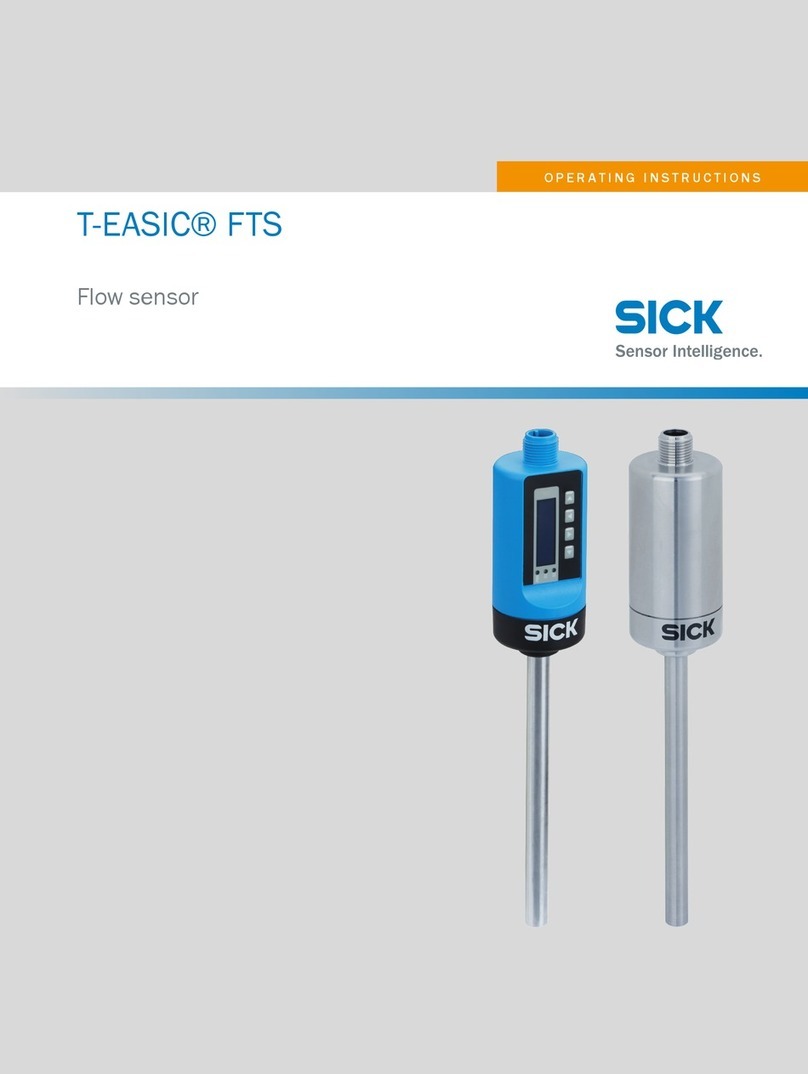
SICK
SICK T-EASIC FTS operating instructions
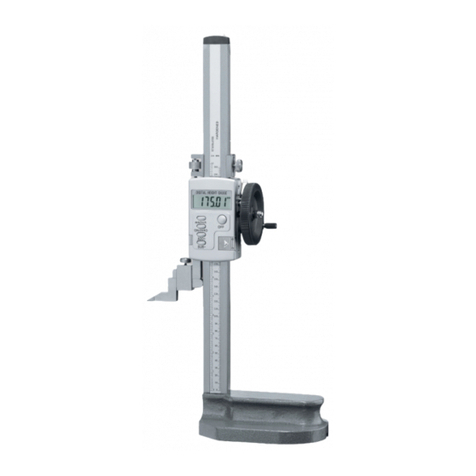
Neriox
Neriox 137781 operating instructions
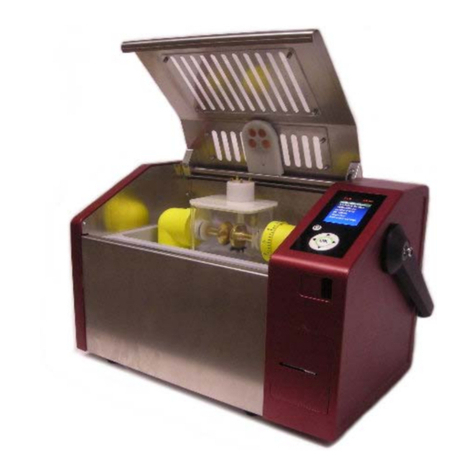
Koehler
Koehler K16175 manual
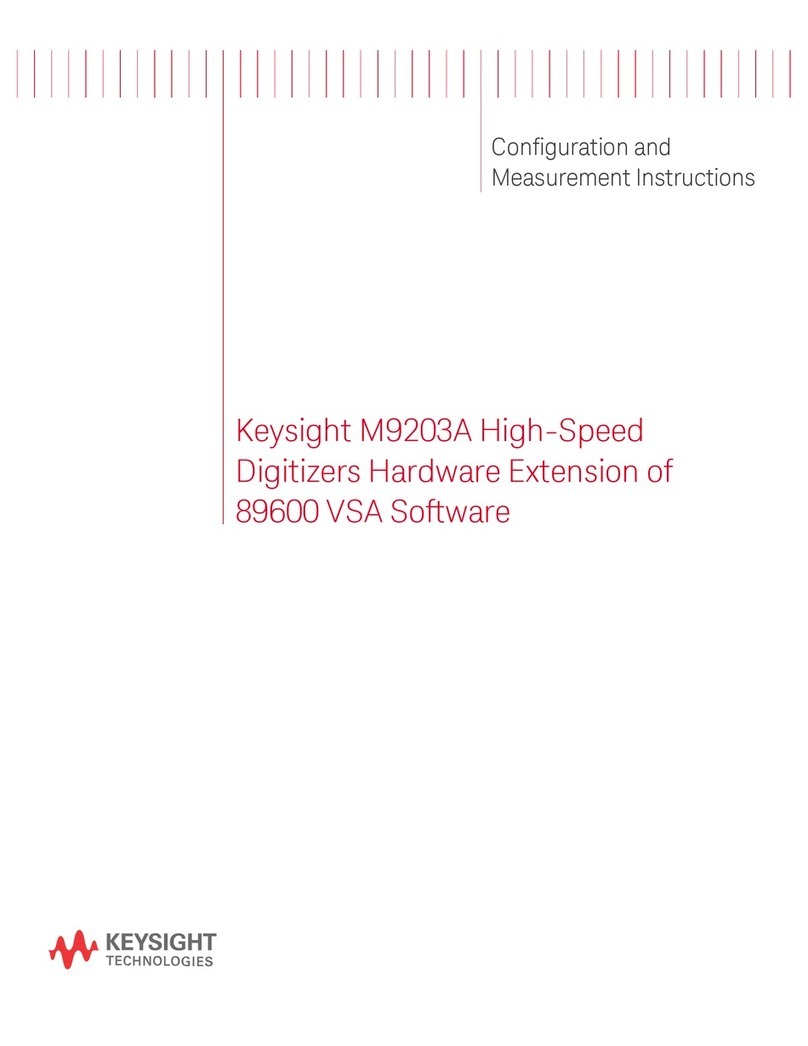
Keysight Technologies
Keysight Technologies M9203A Configuration and Measurement Instructions

